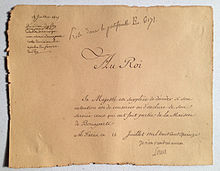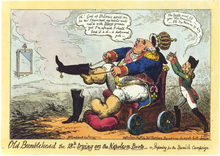Restoration (France)

In the history of France , the Restoration describes the period of restoration of the Bourbon monarchy between the end of the First French Empire and the July Revolution of 1830 .
The restoration epoch was interrupted by the return of Napoleon Bonaparte from exile and the following episode of the Hundred Days . That is why one speaks of the "First Restoration" (French: Première Restoration ) from April 1814 to March 1815 and the "Second Restoration" (French: Seconde Restoration ) from Napoleon's final abdication in June 1815 to the outbreak of the Revolution in July 1830 .
Domestically, the rule of Louis XVIII was. and his younger brother Karl X. were shaped by the conflicts between ultra-royalist and bourgeois-liberal forces. In terms of foreign policy, the focus was on the payment of war debts, the associated withdrawal of the Allied occupation forces and finally the regaining of equality under international law for France.
From the first to the second restoration
Shortly after Napoleon's unconditional abdication on April 12, 1814 and the occupation of the French capital by the victorious coalition, the re-establishment of the Bourbons was initiated. On April 24th, the brother of Louis XVI , who had been in exile since 1791, landed . , Louis Stanislas Xavier Count of Provence in Calais and only a few days later he moved into Paris - together with a group of emigrated nobles . In one of his first official acts, he described the year 1814 as the nineteenth of his government, thereby emphasizing his understanding of the continuity of the Bourbon monarchy. At the same time, however, he recognized the need for confessions to the achievements of the revolutionary epoch and with the Charte constitutionnelle gave France a liberal constitution based on the British model. His attempt at a policy of domestic political balance that had begun during this phase of the first restoration was suddenly interrupted by Napoleon's return from exile and the subsequent episode of the Hundred Days .
Domestic policy: Les deux Frances

After the renewed expulsion of Napoleon and the beginning of the second restoration phase in the summer of 1815, Louis XVIII. continued his domestic political work of balancing the royalist, aristocratic and theocratic world of the ancien régime and the bourgeois, enlightened-liberal France of the revolution and the Napoleonic era. This program of internal consolidation in France was, however, particularly between 1815 and 1820 by the terreur blanche (Eng. "White horror"), bloody reprisals by returning emigrants against supporters of the revolution and Napoleon.

The basis of the restoration phase, a constitutional monarchy , in which the executive was in the hands of the king, while the legislature to a House of Peers and one on the census suffrage based Chamber of Deputies was distributed. In the elections of October 1815, the royalist " Ultras " achieved such success that the king described the parliament as a Chambre introuvable (English: "Chamber that cannot be easily found again"). The attempt of the Ultras to achieve a strengthening of the class aristocratic influence at the expense of the position of royalty was countered by Louis XVIII. with the dissolution of the Chamber of Deputies in September 1816. In the subsequent elections, a chamber majority consisting of moderate royalists came about, which remained in power until 1820. Based on the seating arrangements in parliament at that time, the terms “right” and “left”, which are still used today, developed.
The clashes between the Old and New France (French. Deux Frances ) culminated in the murder of the only at that time dynastic successor, the Duke of Berry , on 13 February 1820. The committed by a fanatical lone murder was the Liberals in the shoes pushed and led to a significant strengthening of the ultra-royalist forces. When Berry's wife Maria Karolina was given birth to a son at the end of September 1820 , the Ultras welcomed him as a "child of miracles" and interpreted the birth as evidence of the divine grace resting on their goals.
After the death of Louis XVIII. in 1824 his brother Charles X took over the government. As a supporter of the Ultras, he made a series of reactionary decisions - such as the compensation of the emigrants for their losses suffered during the revolution in 1825 - which led to a strengthening of the opposition of the liberal bourgeoisie. The decree of the "Juliordonnanzen", in which the Chamber of Deputies was dissolved, the electoral census raised and the freedom of the press further restricted, finally culminated on July 27, 1830, with the outbreak of the July Revolution and the end of the French restoration era.
Return to the European concert

In the field of foreign policy, after the trauma of the double defeat and the occupation of France by Allied troops, the focus was on regaining national sovereignty. At the same time, the reparations debts had to be paid off, for which the victorious powers had set a deadline of five years in the Second Peace of Paris . After this time frame was even shortened by two years, the withdrawal of the occupation troops was decided at the Aachen Congress in 1818. At the same time, through its acceptance into the Holy Alliance , France re-entered the concert of the great powers as the fifth major power alongside Austria, Prussia, Russia and Great Britain.
At the Congress of Verona , which took place four years later, French diplomacy achieved the greatest foreign policy success of the Restoration era. A principle of intervention adopted by the Holy Alliance in 1820 provided for the interference of the great powers in the internal affairs of a country threatened by a revolution. This principle, originally aimed against a renewed flare-up of the revolution in France, was now applied to Spain in order to restore the rule of King Ferdinand VII, who was overthrown in 1820 . The entrustment of France with the military suppression of the insurrection and the successful French invasion of Spain were celebrated by the Ultras as a sign of the regaining of full equality for France.
New foreign policy perspectives opened up for France from the new rivalries within the pentarchy , as they became particularly evident in the course of the Greek War of Independence in the second half of the 1820s. France used this to expand its sphere of influence to the western Mediterranean by leading a successful military expedition against the Dey of Algiers in January 1830 after years of diplomatic tensions and French units occupying all the forts on the coast. The subsequent transformation of Algeria into a province transméditerranéenne laid the foundation for the second French colonial empire.
literature
Tools
- Guillaume de Bertier de Sauvigny and Alfred Fierro: Bibliographie critique des mémoires sur la restauration écrits ou traduits en français , Genève 1988 (annotated bibliography of the French-language memoirs relating to the time of the Restoration).
Source editions
- Archives parlementaires: de 1787 à 1860. Recueil complet des débats législatifs et politiques des Chambres Françaises , imprimé […] sous la direction de Jules Madival et Émile Laurent, deuxième série (1800 à 1860), Paris 1799– (the minutes of the parliamentary sessions a central source; the years from 1815 are recorded in volumes 15ff .; also available as a reprint).
- Procès-verbal des séances de la Chambre des Pairs , Paris 1814– (minutes of the meetings of the French upper house).
Overall representations
- Emmanuel de Waresquiel and Benoît Yvert: Histoire de la Restauration, 1814–1830: naissance de la France moderne , Paris 1996, ISBN 2-262-00912-0 (the standard French work on the history of the restoration in France; under ISBN 2-262 -01901-0 also available in a new edition from 2002 with an updated bibliography).
Magazines
- Revue de la Société d'Histoire de la Restauration , Paris 1988–1991, ISSN 0765-2615 .
- Revue de la Société de la Restauration et de la Monarchie Constitutionnelle , Paris 1992-, ISSN 0765-2615 (successor to the Revue de la Société d'Histoire de la Restauration ).
Web links
- In 1816, the then ultra-royalist publicist and later Foreign Minister François-René de Chateaubriand published his political program in the highly acclaimed De la monarchie selon la charte (German: "About the monarchy according to the charte"). A facsimile of the first edition is available online via the French digitization project Gallica .